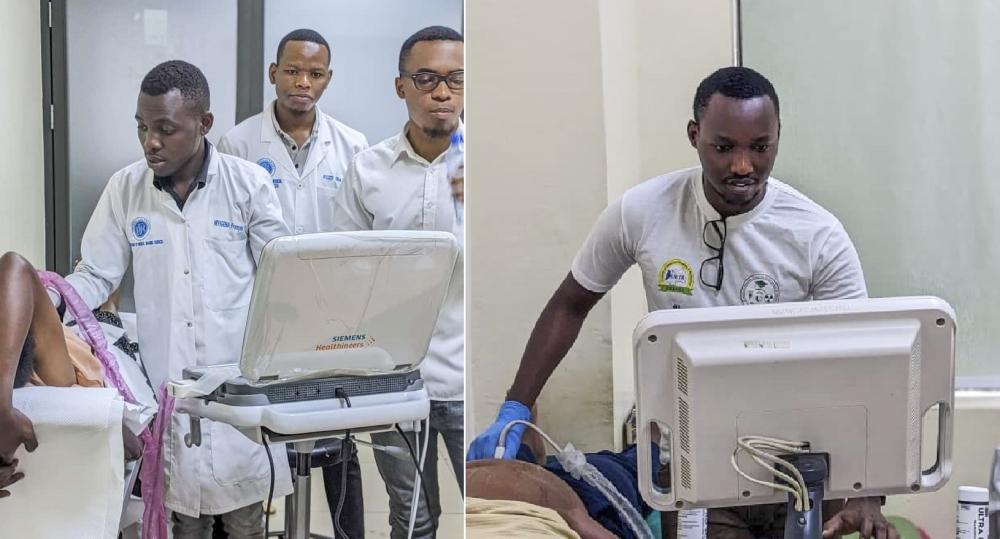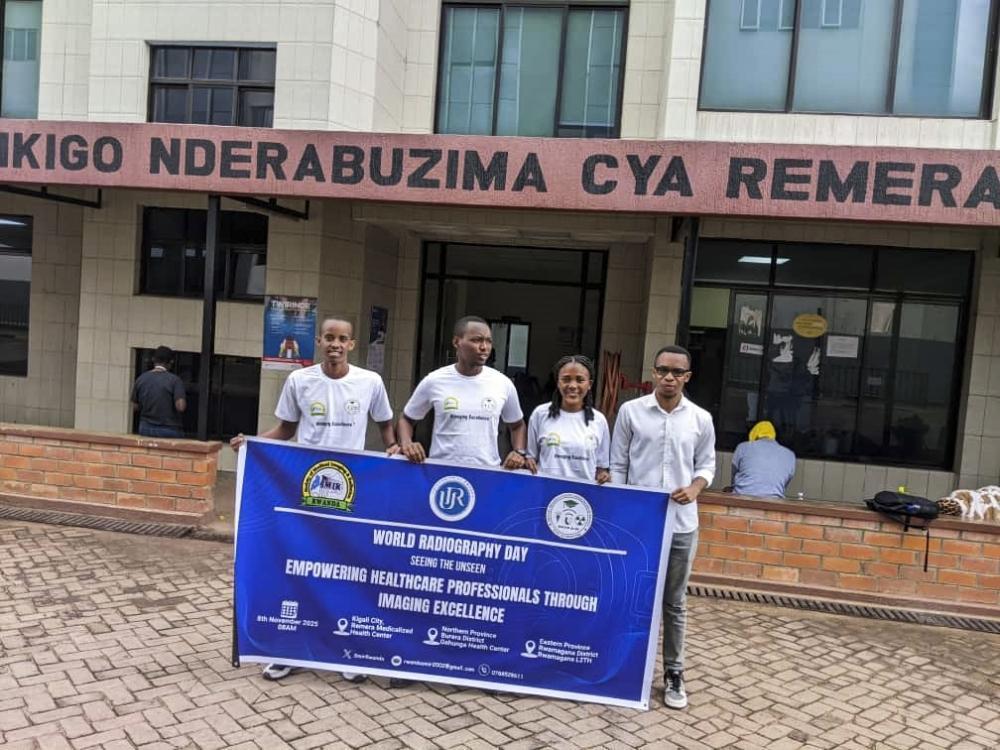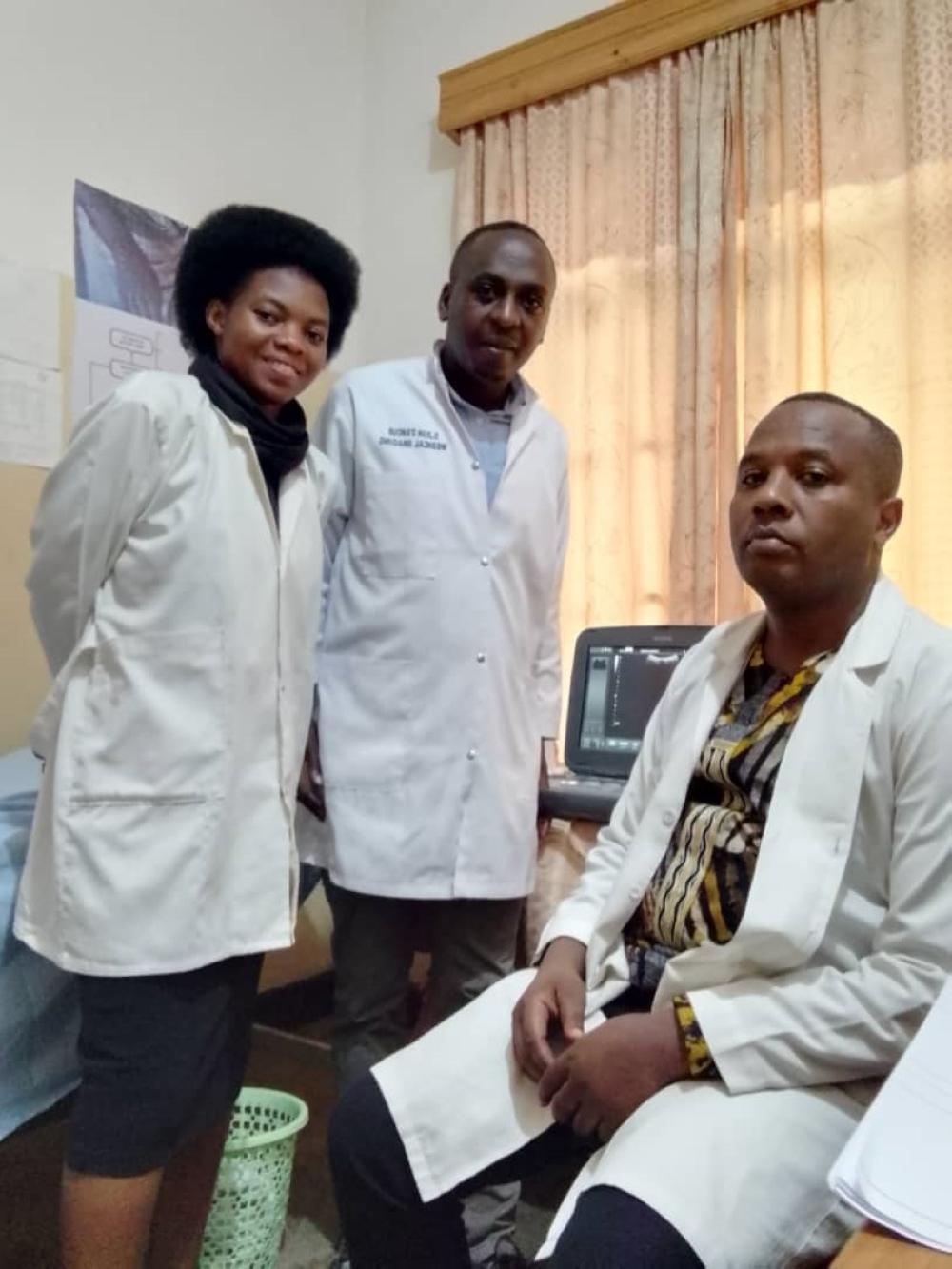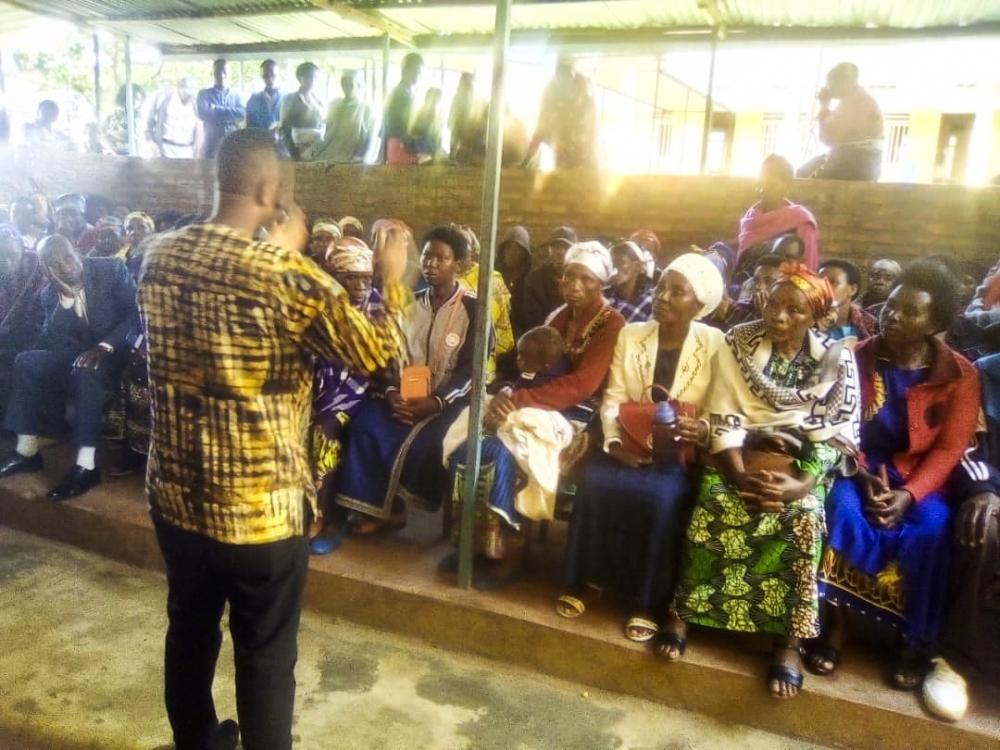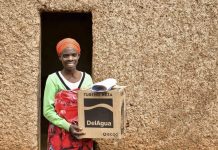Africa-Press – Rwanda. Medical imaging has become one of the most powerful tools in modern healthcare, enabling doctors to detect diseases early, plan treatments precisely, and save lives.
Yet in many communities, especially in low- and middle-income countries, access to imaging services remains limited. In Rwanda, professionals in this field are not only working to bridge that gap but also to change perceptions and bring diagnostic care closer to the people who need it most.
Imaging professionals joined the rest of the world to mark WRD 2025 at Remera Medicalised Health Centre in Kigali on November 8. Courtesy.
This year marks the 130th anniversary of Wilhelm Conrad Roentgen’s discovery of X-rays, a breakthrough that revolutionised medical diagnostics and laid the foundation for modern imaging.
To mark World Radiography Day on November 8, the Society of Medical Imaging and Radiation in Rwanda (SMIR), in partnership with the University of Rwanda and the Society of Medical Imaging Students, organised a series of community outreach activities across the country.
Members of the Society of Medical Imaging and Radiation in Rwanda (SMIR) advocate for improved access to imaging services
The initiative aimed to bring essential imaging services closer to communities by reaching patients at the primary and secondary levels of care.
Through this effort, organisers sought to raise awareness about the importance of radiography in healthcare and to highlight the profession’s contribution to early diagnosis and improved patient outcomes.
Free ultrasound screenings were conducted at Rwamagana Hospital in the East, Remera Medicalised Health Centre in Kigali, and Gahunga Health Centre in Burera District in the Northern Province.
A total of 115 patients were screened, including 92 women, forming 80 per cent of those who were screened while 23 men, accounting for 20 per cent.
Examinations including breast, abdominal, and pelvic ultrasounds were conducted. Of these, 32 patients or 27.8 per cent were found to have abnormalities and were guided on the next steps for further care.
“Our main goal was to raise awareness about the importance of medical imaging for early disease detection and effective patient management,” said Mecthilde Mukangendo, President of the Society of Medical Imaging and Radiation in Rwanda.
“Many people still misunderstand what imaging entails or fear it because of misconceptions about radiation. These outreach activities are a way of building trust and showing that imaging is not just about machines, it’s about saving lives,” she said.
Raising awareness through outreach
According to Mukangendo, despite significant progress in Rwanda’s healthcare sector, medical imaging remains underutilised in many areas. Limited awareness about its benefits and fears surrounding radiation exposure often leads patients to seek care only after their conditions have advanced.
This makes treatment more complex and expensive, undermining the country’s goal of achieving Universal Health Coverage (UHC).
By taking imaging services to communities, the outreach not only improved access but also helped patients better understand the value of screening and early diagnosis.
It also demonstrated how imaging professionals contribute to Rwanda’s broader public health priorities and the global push for equitable healthcare access.
This year’s global theme, “Empowering Healthcare through Imaging Excellence”, captured that spirit. It emphasized the vital role of medical imaging professionals in enhancing patient outcomes and ensuring quality care through accurate diagnosis.
“Imaging excellence empowers healthcare providers by giving them reliable information to make timely and effective decisions,” said Dr. Theonille Mukabagorora, a member of SMIR’s executive committee and advisor.
“In Rwanda, it reflects our efforts to strengthen diagnostic capacity, promote patient safety, and expand access to quality healthcare at all levels,” she adds
Why ultrasound?
Among the different imaging modalities, ultrasound was chosen because of its versatility, safety, and accessibility. It provides real-time imaging without radiation exposure, making it ideal for community-based healthcare, especially in areas with limited infrastructure.
“Ultrasound is portable, affordable, and safe for everyone, including pregnant women and children,” explained Dr. Mukabagorora.
“It can be used in remote or underserved areas and can detect a wide range of conditions, from abdominal masses and gynaecological disorders to musculoskeletal and vascular abnormalities.”
Ndengeyabagabo Augustin speaks to women at Ruhengeri Hospital
At Gahunga Health Centre, sonographer Augustin Ndengeyabagabo from Ruhengeri Hospital was among the professionals leading the activity. Working alongside students and colleagues, he conducted free scans and offered health education to local residents, emphasising the importance of early screening.
As part of the international day, medical imaging professionals interacting with patients, offering explanations, and sharing insights about how ultrasound works, a moment that reflected both compassion and technical expertise.
Linking education, service, and community
Beyond the clinical benefits, the outreach was also an opportunity for collaboration between the University of Rwanda, practicing radiographers, and students. It allowed trainees to gain hands-on experience in real community settings while learning the values of empathy and people-centred care.
“This initiative bridged the gap between education and practice,” said Mukangendo. “Our students had the chance to serve, to apply what they learn, and to understand the human stories behind the images they interpret.”
The exercise also fostered mentorship and teamwork between generations of professionals, reinforcing SMIR’s mission to build a skilled, motivated, and community-oriented imaging workforce.
What the future holds
From the outreach, the Society of Medical Imaging and Radiation in Rwanda drew several lessons. First, ultrasound remains one of the most effective ways to extend imaging services to underserved populations. Second, sustained collaboration among universities, health institutions, and professional bodies is key to expanding access and maintaining quality.
“This activity showed us the power of partnerships,” said Dr. Mukabagorora. “When academia, professionals, and communities work together, we can make a tangible difference in people’s health.”
SMIR plans to extend similar initiatives to more districts in the coming years, engage additional stakeholders, and continue to advocate for investment in diagnostic imaging, radiation protection, and continuous professional development.
The Society also echoes global calls, including the World Health Organisation’s Resolution WHA78.13 (2025) on strengthening medical imaging, urging policymakers and partners to integrate imaging more fully into national health strategies.
A call for continued investment
While Rwanda has made commendable progress in acquiring modern imaging technologies, challenges remain in ensuring equitable access and adequate human resources. For SMIR, World Radiography Day serves as a reminder that diagnostic imaging is not a luxury but a cornerstone of effective healthcare.
“Every Rwandan deserves access to timely and accurate diagnosis,” said Mukangendo. “Medical imaging is essential to early detection, effective treatment, and achieving Universal Health Coverage. It should reach everyone, from the most advanced hospital to the most remote health post.”
As the global community marks 130 years since the discovery of X-rays, Rwanda’s imaging professionals are proving that innovation is not only about machines but about compassion, service, and the will to make healthcare equitable.
Through outreach, education, and collaboration, they continue to turn imaging excellence into a tool for empowerment, one community at a time.
For More News And Analysis About Rwanda Follow Africa-Press

